Phosphorus Functional Genes Control Rice Yield via Microbial Biomass Phosphorus and Plant Phosphorus Uptake in a Rice–Oilseed Rape Rotation System Compared with a Rice–Wheat Rotation System
Abstract
1. Introduction
2. Materials and Methods
2.1. Experimental Site and Materials
2.2. Soil and Plant Sampling
2.3. Analysis of Soil Properties and Plant P Contents
2.4. Soil Microbial Community Characterization
2.5. Analysis of Soil P Mineralization
2.6. Statistical Analysis
3. Results
3.1. Rice Yield and Nutrient Uptake
3.2. Variations in Soil Properties
3.3. Soil Microbial Community and P Functional Genes
3.4. Effects of Soil Properties and Microorganisms on Rice Yield
4. Discussion
4.1. RO Rotation Activates Soil P and Promotes Plant P Uptake
4.2. Soil MBP Affects P Bioavailability in the RO Rotation System
4.3. Relationships Between Microbial P Functional Genes and Rice Yield in the RO Rotation System
4.4. Practical Implications for Phosphorus Management and Crop Rotation
5. Conclusions
Supplementary Materials
Author Contributions
Funding
Data Availability Statement
Acknowledgments
Conflicts of Interest
References
- He, X.; Batáry, P.; Zou, Y.; Zhou, W.; Wang, G.; Liu, Z.; Bai, Y.; Gong, S.; Zhu, Z.; Settele, J.; et al. Agricultural Diversification Promotes Sustainable and Resilient Global Rice Production. Nat. Food 2023, 4, 788–796. [Google Scholar] [CrossRef] [PubMed]
- Yang, X.; Xiong, J.; Du, T.; Ju, X.; Gan, Y.; Li, S.; Xia, L.; Shen, Y.; Pacenka, S.; Steenhuis, T.S.; et al. Diversifying Crop Rotation Increases Food Production, Reduces Net Greenhouse Gas Emissions and Improves Soil Health. Nat. Commun. 2024, 15, 198. [Google Scholar] [CrossRef]
- Van Dijk, M.; Morley, T.; Rau, M.L.; Saghai, Y. A Meta-Analysis of Projected Global Food Demand and Population at Risk of Hunger for the Period 2010–2050. Nat. Food 2021, 2, 494–501. [Google Scholar] [CrossRef] [PubMed]
- Yuan, S.; Linquist, B.A.; Wilson, L.T.; Cassman, K.G.; Stuart, A.M.; Pede, V.; Miro, B.; Saito, K.; Agustiani, N.; Aristya, V.E.; et al. Sustainable Intensification for a Larger Global Rice Bowl. Nat. Commun. 2021, 12, 7163. [Google Scholar] [CrossRef]
- Ladha, J.K.; Dawe, D.; Pathak, H.; Padre, A.T.; Yadav, R.L.; Singh, B.; Singh, Y.; Singh, Y.; Singh, P.; Kundu, A.L.; et al. How Extensive Are Yield Declines in Long-Term Rice–Wheat Experiments in Asia? Field Crops Res. 2003, 81, 159–180. [Google Scholar] [CrossRef]
- Weiser, C.; Fuß, R.; Kage, H.; Flessa, H. Do Farmers in Germany Exploit the Potential Yield and Nitrogen Benefits from Preceding Oilseed Rape in Winter Wheat Cultivation? Arch. Agron. Soil Sci. 2018, 64, 25–37. [Google Scholar] [CrossRef]
- Zhang, H.; Luo, G.; Wang, Y.; Fei, J.; Xiangmin, R.; Peng, J.; Tian, C.; Zhang, Y. Crop Rotation-Driven Change in Physicochemical Properties Regulates Microbial Diversity, Dominant Components, and Community Complexity in Paddy Soils. Agric. Ecosyst. Environ. 2023, 343, 108278. [Google Scholar] [CrossRef]
- Fang, Y.; Ren, T.; Zhang, S.; Liu, Y.; Liao, S.; Li, X.; Cong, R.; Lu, J. Rotation with Oilseed Rape as the Winter Crop Enhances Rice Yield and Improves Soil Indigenous Nutrient Supply. Soil Tillage Res. 2021, 212, 105065. [Google Scholar] [CrossRef]
- Zhu, Y.; Liao, S.P.; Liu, Y.; Li, X.K.; Ren, T.; Cong, R.H.; Lu, J.W. Differences of annual nutrient budgets between rapeseed–rice and wheat–rice rotations in the Yangtze River Basin. J. Plant Nutr. Fertil. 2019, 25, 64–73. [Google Scholar] [CrossRef]
- Kong, F.; Zhang, X.; Zhu, Y.; Yang, H.; Li, F. Alternate Wetting and Drying Irrigation Reduces P Availability in Paddy Soil Irrespective of Straw Incorporation. Agronomy 2022, 12, 1718. [Google Scholar] [CrossRef]
- Igwe, C.A.; Zarei, M.; Stahr, K. Fe and Al Oxides Distribution in Some Ultisols and Inceptisols of Southeastern Nigeria in Relation to Soil Total Phosphorus. Environ. Earth Sci. 2010, 60, 1103–1111. [Google Scholar] [CrossRef]
- Von Tucher, S.; Hörndl, D.; Schmidhalter, U. Interaction of Soil pH and Phosphorus Efficacy: Long-Term Effects of P Fertilizer and Lime Applications on Wheat, Barley, and Sugar Beet. Ambio 2018, 47, 41–49. [Google Scholar] [CrossRef]
- Jin, J.; Fang, Y.; Liu, C.; Eltohamy, K.M.; He, S.; Li, F.; Lu, Y.; Liang, X. Reduced Colloidal Phosphorus Release from Paddy Soils: A Synergistic Effect of Micro-/Nano-Sized Biochars and Intermittent Anoxic Condition. Sci. Total Environ. 2023, 905, 167104. [Google Scholar] [CrossRef]
- Lan, Z.M.; Lin, X.J.; Wang, F.; Zhang, H.; Chen, C.R. Phosphorus Availability and Rice Grain Yield in a Paddy Soil in Response to Long-Term Fertilization. Biol. Fertil. Soils 2012, 48, 579–588. [Google Scholar] [CrossRef]
- Hou, E.; Luo, Y.; Kuang, Y.; Chen, C.; Lu, X.; Jiang, L.; Luo, X.; Wen, D. Global Meta-Analysis Shows Pervasive Phosphorus Limitation of Aboveground Plant Production in Natural Terrestrial Ecosystems. Nat. Commun. 2020, 11, 637. [Google Scholar] [CrossRef]
- Wang, Y.; Zhao, X.; Wang, L.; Zhao, P.-H.; Zhu, W.-B.; Wang, S.-Q. Phosphorus Fertilization to the Wheat-Growing Season Only in a Rice–Wheat Rotation in the Taihu Lake Region of China. Field Crops Res. 2016, 198, 32–39. [Google Scholar] [CrossRef]
- Wang, Y.; Zhang, H.; Zhang, Y.; Fei, J.; Xiangmin, R.; Peng, J.; Luo, G. Crop Rotation-Driven Changes in Rhizosphere Metabolite Profiles Regulate Soil Microbial Diversity and Functional Capacity. Agric. Ecosyst. Environ. 2023, 358, 108716. [Google Scholar] [CrossRef]
- Lyu, Y.; Tang, H.; Li, H.; Zhang, F.; Rengel, Z.; Whalley, W.R.; Shen, J. Major Crop Species Show Differential Balance between Root Morphological and Physiological Responses to Variable Phosphorus Supply. Front. Plant Sci. 2016, 7, 1939. [Google Scholar] [CrossRef]
- Łukowiak, R.; Grzebisz, W.; Sassenrath, G.F. New Insights into Phosphorus Management in Agriculture—A Crop Rotation Approach. Sci. Total Environ. 2016, 542, 1062–1077. [Google Scholar] [CrossRef]
- Xu, X.; Mao, X.; Van Zwieten, L.; Niazi, N.K.; Lu, K.; Bolan, N.S.; Wang, H. Wetting-Drying Cycles during a Rice-Wheat Crop Rotation Rapidly (Im)Mobilize Recalcitrant Soil Phosphorus. J. Soils Sediments 2020, 20, 3921–3930. [Google Scholar] [CrossRef]
- De Vries, F.T.; Griffiths, R.I.; Knight, C.G.; Nicolitch, O.; Williams, A. Harnessing Rhizosphere Microbiomes for Drought-Resilient Crop Production. Science 2020, 368, 270–274. [Google Scholar] [CrossRef] [PubMed]
- Rawat, P.; Das, S.; Shankhdhar, D.; Shankhdhar, S.C. Phosphate-Solubilizing Microorganisms: Mechanism and Their Role in Phosphate Solubilization and Uptake. J. Soil Sci. Plant Nutr. 2021, 21, 49–68. [Google Scholar] [CrossRef]
- Singh, B.K.; Trivedi, P.; Egidi, E.; Macdonald, C.A.; Delgado-Baquerizo, M. Crop Microbiome and Sustainable Agriculture. Nat. Rev. Microbiol. 2020, 18, 601–602. [Google Scholar] [CrossRef]
- Song, D.; Dai, X.; Guo, T.; Cui, J.; Zhou, W.; Huang, S.; Shen, J.; Liang, G.; He, P.; Wang, X.; et al. Organic Amendment Regulates Soil Microbial Biomass and Activity in Wheat-Maize and Wheat-Soybean Rotation Systems. Agric. Ecosyst. Environ. 2022, 333, 107974. [Google Scholar] [CrossRef]
- Liu, Y.; Liu, R.; Ghimire, R.; Zhang, N.; Zhou, S.; Zhao, F.; Wang, J. Linking Soil Phosphorus Fractions to Associated Microbial Functional Profiles under Crop Rotation on the Loess Plateau of China. Soil Tillage Res. 2023, 233, 105809. [Google Scholar] [CrossRef]
- Peng, Y.; Duan, Y.; Huo, W.; Xu, M.; Yang, X.; Wang, X.; Wang, B.; Blackwell, M.S.A.; Feng, G. Soil Microbial Biomass Phosphorus Can Serve as an Index to Reflect Soil Phosphorus Fertility. Biol. Fertil. Soils 2021, 57, 657–669. [Google Scholar] [CrossRef]
- Wang, K.; Ren, T.; Yan, J.; Zhu, D.; Liao, S.; Zhang, Y.; Lu, Z.; Cong, R.; Li, X.; Lu, J. Straw Returning Mediates Soil Microbial Biomass Carbon and Phosphorus Turnover to Enhance Soil Phosphorus Availability in a Rice-Oilseed Rape Rotation with Different Soil Phosphorus Levels. Agric. Ecosyst. Environ. 2022, 335, 107991. [Google Scholar] [CrossRef]
- Raymond, N.S.; Gómez-Muñoz, B.; Van Der Bom, F.J.T.; Nybroe, O.; Jensen, L.S.; Müller-Stöver, D.S.; Oberson, A.; Richardson, A.E. Phosphate-solubilising Microorganisms for Improved Crop Productivity: A Critical Assessment. New Phytol. 2021, 229, 1268–1277. [Google Scholar] [CrossRef] [PubMed]
- Zhang, D.; Kuzyakov, Y.; Zhu, H.; Alharbi, H.A.; Li, H.; Rengel, Z. Increased Microbial Biomass and Turnover Underpin Efficient Phosphorus Acquisition by Brassica Chinensis. Soil Tillage Res. 2022, 223, 105492. [Google Scholar] [CrossRef]
- Hummel, C.; Boitt, G.; Santner, J.; Lehto, N.J.; Condron, L.; Wenzel, W.W. Co-Occurring Increased Phosphatase Activity and Labile P Depletion in the Rhizosphere of Lupinus Angustifolius Assessed with a Novel, Combined 2D-Imaging Approach. Soil Biol. Biochem. 2021, 153, 107963. [Google Scholar] [CrossRef]
- Lu, J.; Jia, P.; Feng, S.; Wang, Y.; Zheng, J.; Ou, S.; Wu, Z.; Liao, B.; Shu, W.; Liang, J.; et al. Remarkable Effects of Microbial Factors on Soil Phosphorus Bioavailability: A Country-scale Study. Glob. Change Biol. 2022, 28, 4459–4471. [Google Scholar] [CrossRef] [PubMed]
- Dai, Z.; Liu, G.; Chen, H.; Chen, C.; Wang, J.; Ai, S.; Wei, D.; Li, D.; Ma, B.; Tang, C.; et al. Long-Term Nutrient Inputs Shift Soil Microbial Functional Profiles of Phosphorus Cycling in Diverse Agroecosystems. ISME J. 2020, 14, 757–770. [Google Scholar] [CrossRef] [PubMed]
- Wang, S.; Song, M.; Wang, C.; Dou, X.; Wang, X.; Li, X. Mechanisms Underlying Soil Microbial Regulation of Available Phosphorus in a Temperate Forest Exposed to Long-Term Nitrogen Addition. Sci. Total Environ. 2023, 904, 166403. [Google Scholar] [CrossRef]
- Wu, X.; Rensing, C.; Han, D.; Xiao, K.-Q.; Dai, Y.; Tang, Z.; Liesack, W.; Peng, J.; Cui, Z.; Zhang, F. Genome-Resolved Metagenomics Reveals Distinct Phosphorus Acquisition Strategies between Soil Microbiomes. mSystems 2022, 7, e01107-21. [Google Scholar] [CrossRef] [PubMed]
- Wang, H.; Chen, J.; Ruan, Y.; Sun, W.; Wang, S.; Wang, H.; Zhang, Y.; Guo, J.; Wang, Y.; Guo, H.; et al. Metagenomes Reveal the Effect of Crop Rotation Systems on Phosphorus Cycling Functional Genes and Soil Phosphorus Avail–Ability. Agric. Ecosyst. Environ. 2024, 364, 108886. [Google Scholar] [CrossRef]
- IUSS Working Group WRB. World Reference Base for Soil Resources 2022: International Soil Classification System for Naming Soils and Creating Legends for Soil Maps, 4th ed.; International Union of Soil Sciences: Vienna, Austria, 2022; ISBN 979-8-9862451-1-9. [Google Scholar]
- Bu, R.; Han, S.; Cheng, W.; Wu, Y.; Tang, S.; Li, M.; Wang, H.; Ge, Z.; Wu, J. Deciphering the Role of Particulate Organic Matter in Soil Nitrogen Transformation in Rice–Rapeseed and Rice–Wheat Rotation Systems. Appl. Soil Ecol. 2024, 193, 105146. [Google Scholar] [CrossRef]
- Olsen, S.R. Estimation of Available Phosphorus in Soils by Extraction with Sodium Bicarbonate; No. 939; Circular/United States Department of Agriculture: Washington, DC, USA, 1954.
- Bell, C.W.; Fricks, B.E.; Rocca, J.D.; Steinweg, J.M.; McMahon, S.K.; Wallenstein, M.D. High-Throughput Fluorometric Measurement of Potential Soil Extracellular Enzyme Activities. JoVE 2013, 81, 50961. [Google Scholar] [CrossRef]
- Wu, J.; Joergensen, R.G.; Pommerening, B.; Chaussod, R.; Brookes, P.C. Measurement of Soil Microbial Biomass C by Fumigation-Extraction—An Automated Procedure. Soil Biol. Biochem. 1990, 22, 1167–1169. [Google Scholar] [CrossRef]
- Thomas, R.L.; Sheard, R.W.; Moyer, J.R. Comparison of Conventional and Automated Procedures for Nitrogen, Phosphorus, and Potassium Analysis of Plant Material Using a Single Digestion1. Agron. J. 1967, 59, 240–243. [Google Scholar] [CrossRef]
- Caicedo, H.H.; Hashimoto, D.A.; Caicedo, J.C.; Pentland, A.; Pisano, G.P. Overcoming Barriers to Early Disease Intervention. Nat. Biotechnol. 2020, 38, 669–673. [Google Scholar] [CrossRef]
- Ryan, M.H.; Kirkegaard, J.A.; Angus, J.F. Brassica Crops Stimulate Soil Mineral N Accumulation. Soil Res. 2006, 44, 367. [Google Scholar] [CrossRef]
- Yang, B.; Zhang, K.; Jin, X.; Yan, J.; Lu, S.; Shen, Q.; Guo, L.; Hong, Y.; Wang, X.; Guo, L. Acylation of Non-specific Phospholipase C4 Determines Its Function in Plant Response to Phosphate Deficiency. Plant J. 2021, 106, 1647–1659. [Google Scholar] [CrossRef]
- Yang, B.; Li, J.; Yan, J.; Zhang, K.; Ouyang, Z.; Lu, Y.; Wei, H.; Li, Q.; Yao, X.; Lu, S.; et al. Non-specific Phospholipase C4 Hydrolyzes Phosphosphingolipids and Phosphoglycerolipids and Promotes Rapeseed Growth and Yield. J. Integr. Plant Biol. 2023, 65, 2421–2436. [Google Scholar] [CrossRef]
- Richardson, A.E.; Simpson, R.J. Soil Microorganisms Mediating Phosphorus Availability Update on Microbial Phosphorus. Plant Physiol. 2011, 156, 989–996. [Google Scholar] [CrossRef] [PubMed]
- Liu, J.; Xu, W.; Zhang, Q.; Liao, W.; Li, L.; Chen, S.; Yang, J.; Wang, Z.; Xu, F. OsPHR2-Mediated Recruitment of Pseudomonadaceae Enhances Rice Phosphorus Uptake. Plant Commun. 2024, 5, 100930. [Google Scholar] [CrossRef]
- Liu, J.; Li, F.Y.; Liu, J.; Wang, S.; Liu, H.; Ding, Y.; Ji, L. Grazing Promotes Soil Phosphorus Cycling by Enhancing Soil Microbial Functional Genes for Phosphorus Transformation in Plant Rhizosphere in a Semi-Arid Natural Grassland. Geoderma 2023, 430, 116303. [Google Scholar] [CrossRef]
- Liu, S.; Zeng, J.; Yu, H.; Wang, C.; Yang, Y.; Wang, J.; He, Z.; Yan, Q. Antimony Efflux Underpins Phosphorus Cycling and Resistance of Phosphate-Solubilizing Bacteria in Mining Soils. ISME J. 2023, 17, 1278–1289. [Google Scholar] [CrossRef] [PubMed]
- Rasul, M.; Yasmin, S.; Suleman, M.; Zaheer, A.; Reitz, T.; Tarkka, M.T.; Islam, E.; Mirza, M.S. Glucose Dehydrogenase Gene Containing Phosphobacteria for Biofortification of Phosphorus with Growth Promotion of Rice. Microbiol. Res. 2019, 223–225, 1–12. [Google Scholar] [CrossRef]
- Shi, Y.; Delgado-Baquerizo, M.; Li, Y.; Yang, Y.; Zhu, Y.-G.; Peñuelas, J.; Chu, H. Abundance of Kinless Hubs within Soil Microbial Networks Are Associated with High Functional Potential in Agricultural Ecosystems. Environ. Int. 2020, 142, 105869. [Google Scholar] [CrossRef]
- He, J.; He, J.; Li, H.; Yu, Y.; Qian, L.; Tang, L.; Zheng, Y.; Xiao, J. Continuous Intercropping Increases the Depletion of Soil Available and Non-Labile Phosphorus. Agronomy 2024, 14, 1121. [Google Scholar] [CrossRef]
- Nerger, R.; Klüver, K.; Cordsen, E.; Fohrer, N. Intensive Long-Term Monitoring of Soil Organic Carbon and Nutrients in Northern Germany. Nutr. Cycl. Agroecosyst. 2020, 116, 57–69. [Google Scholar] [CrossRef]
- Fischer, P.; Pöthig, R.; Venohr, M. The Degree of Phosphorus Saturation of Agricultural Soils in Germany: Current and Future Risk of Diffuse P Loss and Implications for Soil P Management in Europe. Sci. Total Environ. 2017, 599–600, 1130–1139. [Google Scholar] [CrossRef] [PubMed]
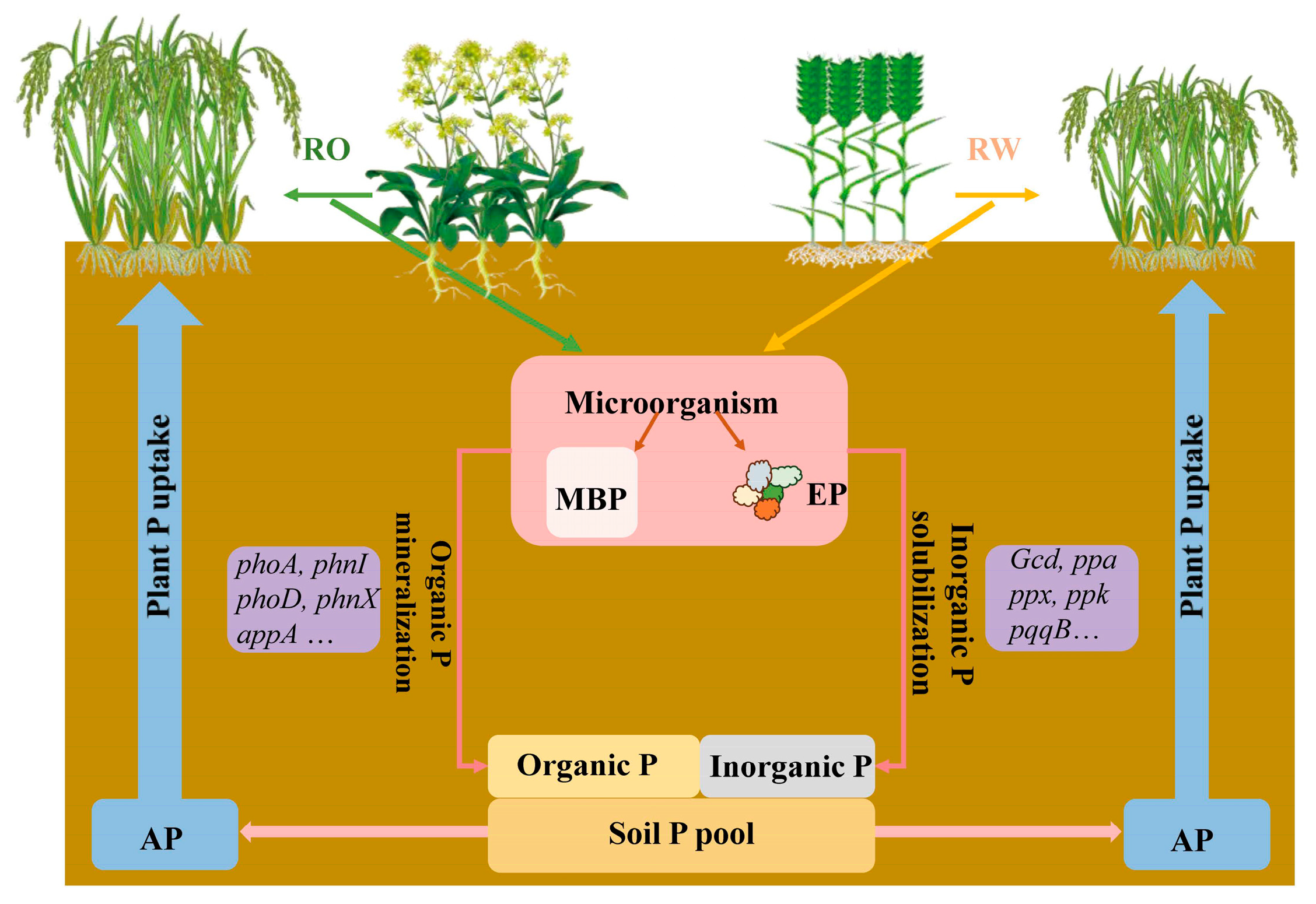




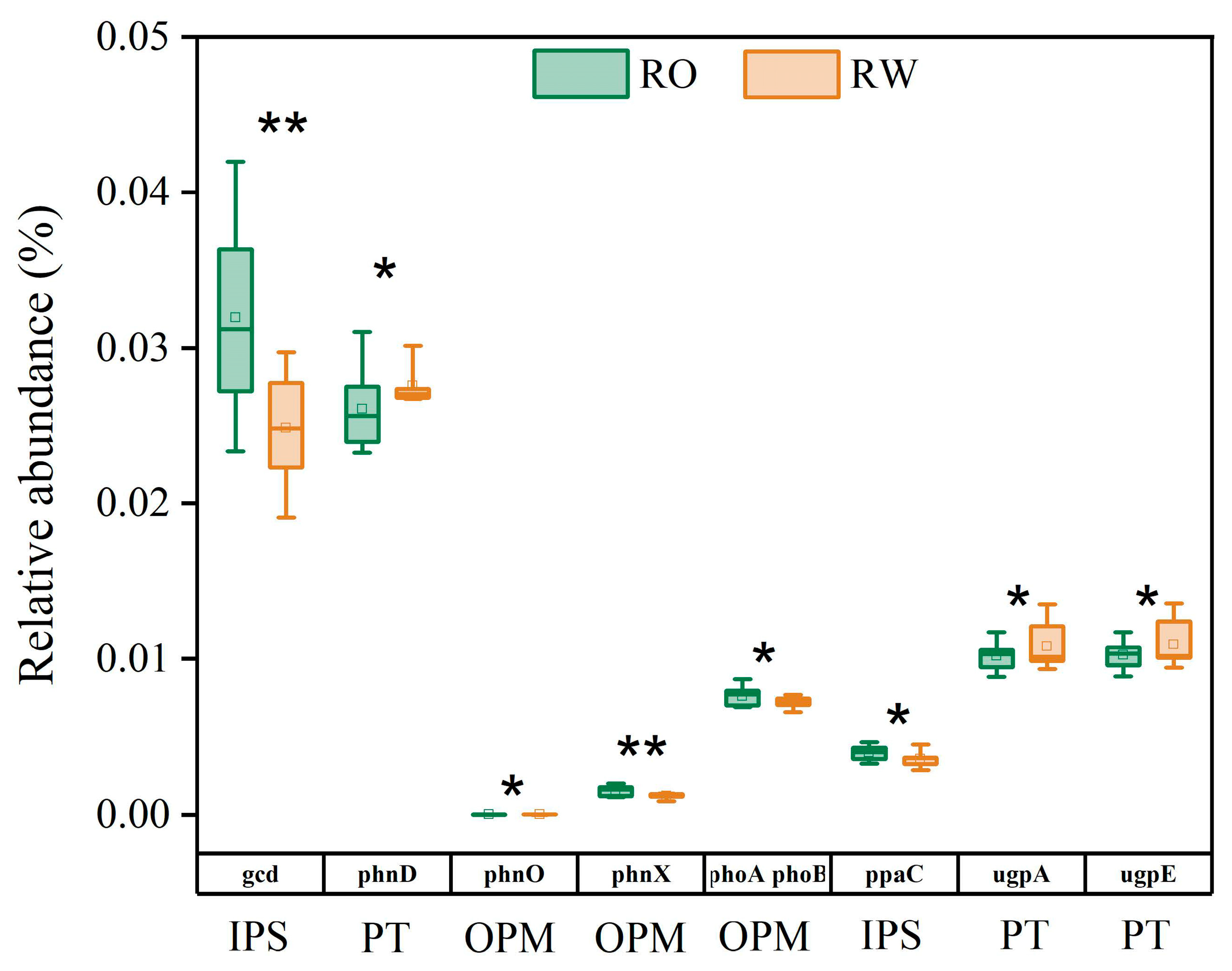
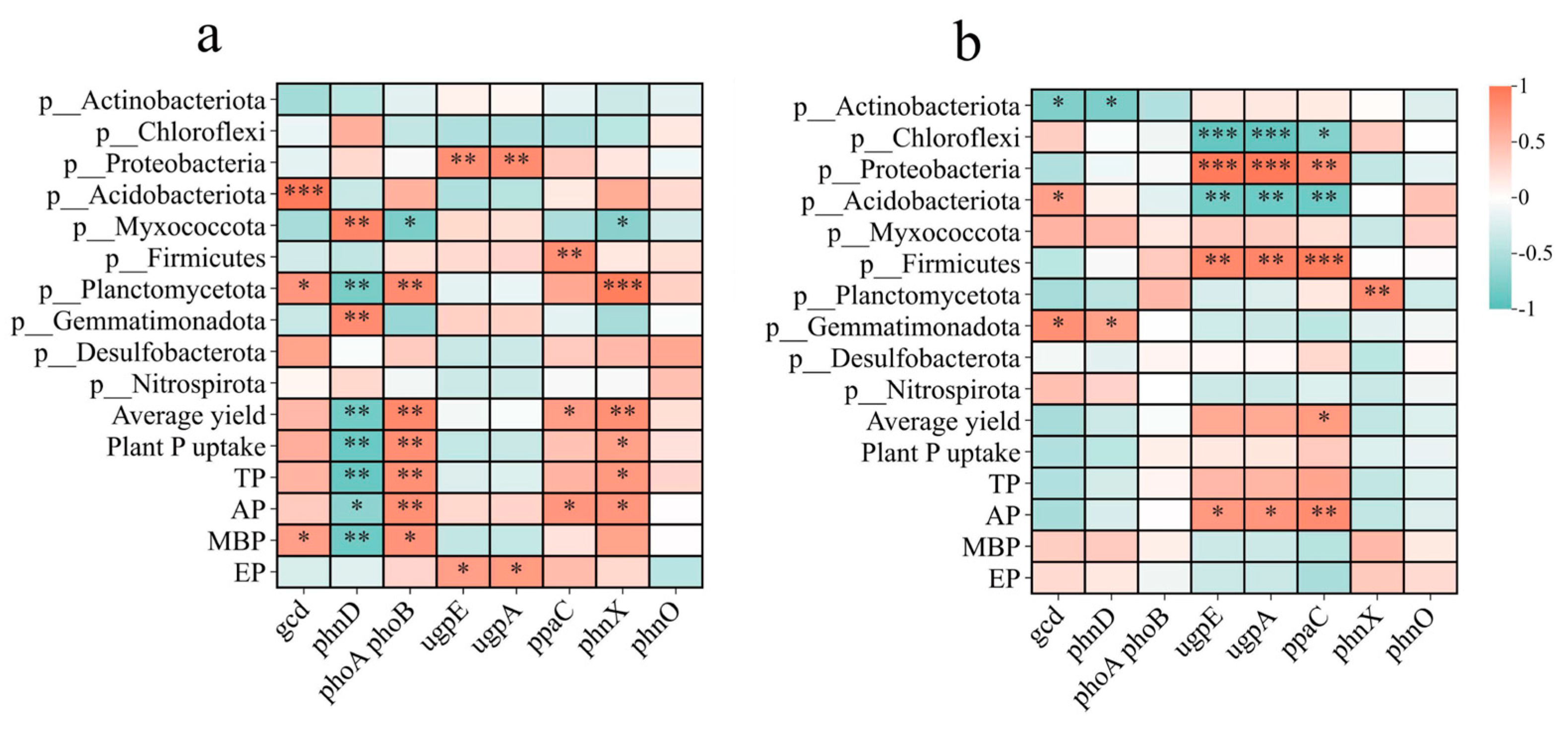
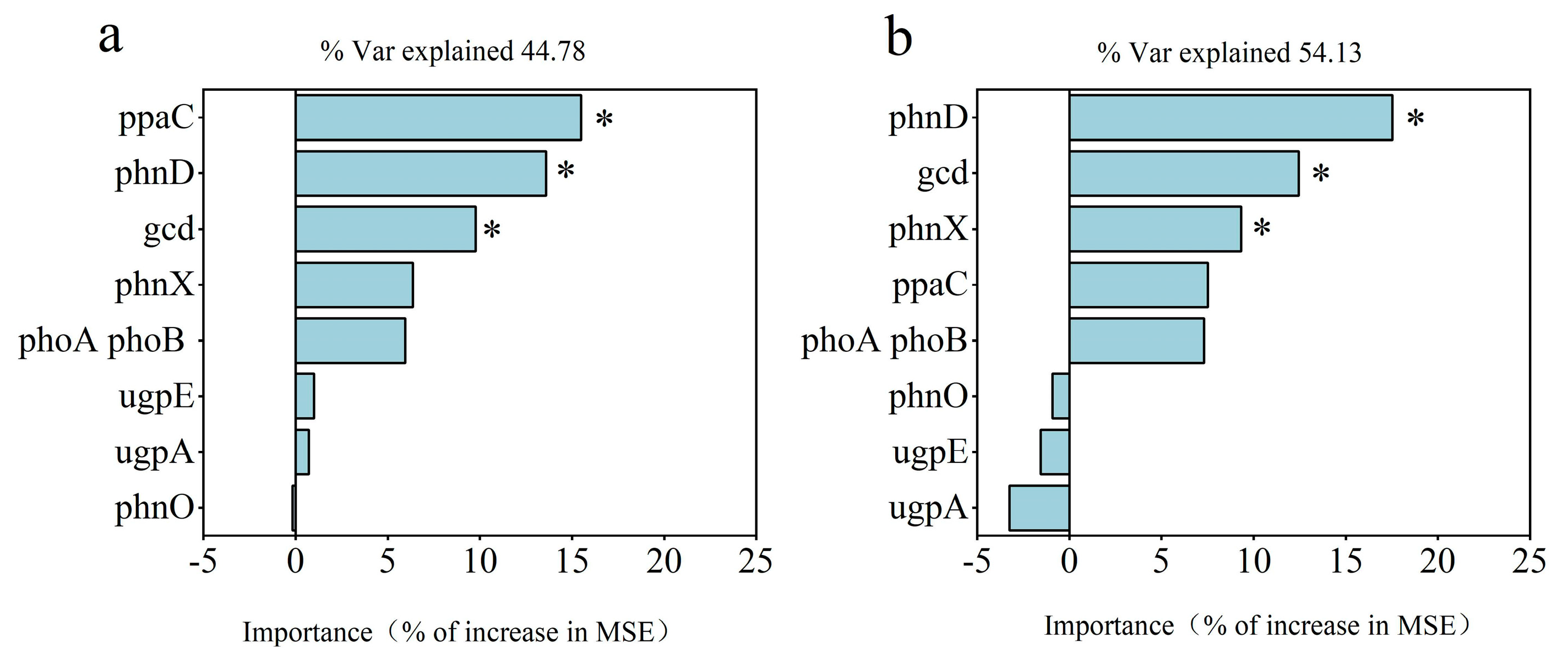
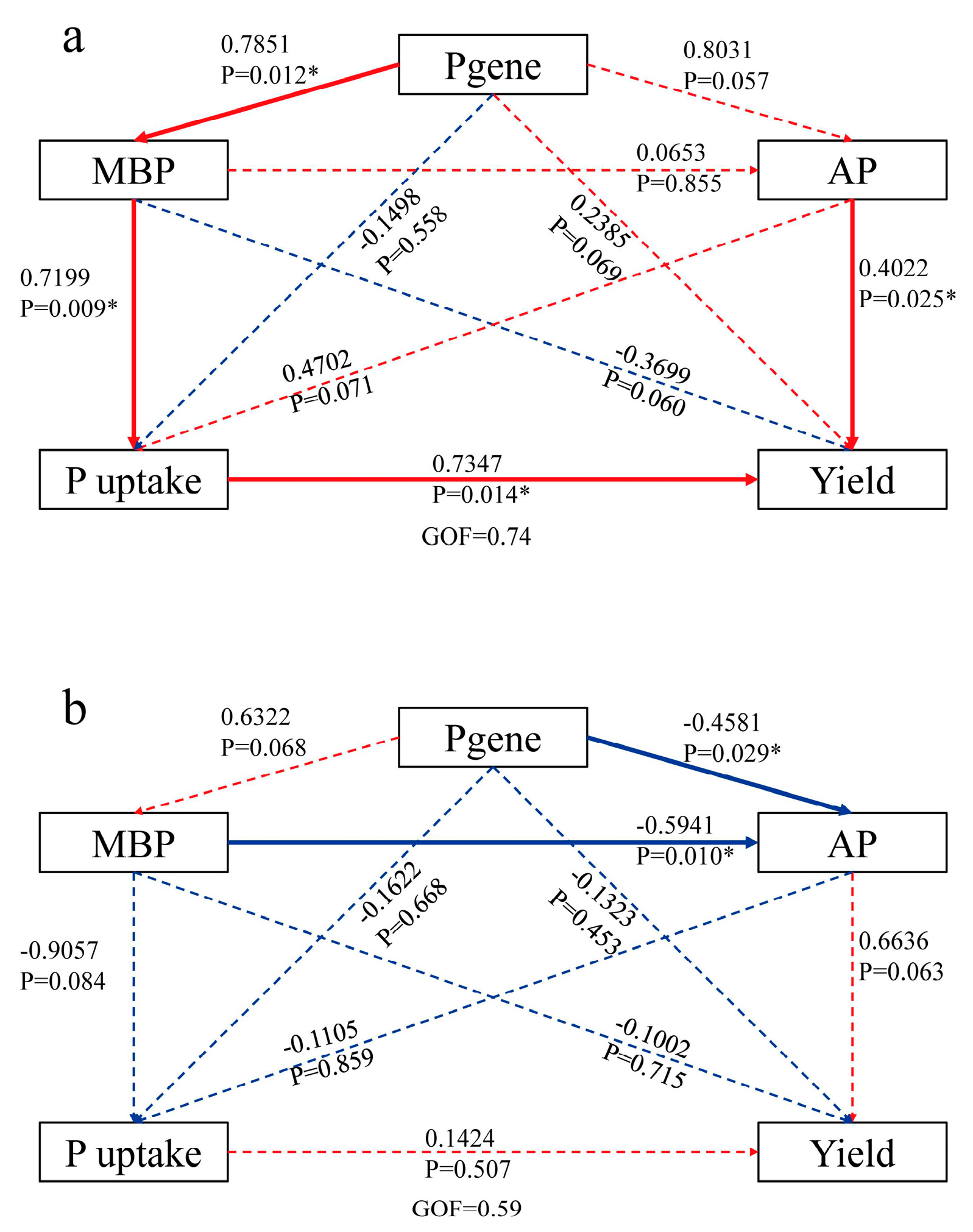
| Treatment | Grain P Uptake (kg ha−1) | Straw P Uptake (kg ha−1) | Plant P Uptake (kg ha−1) | |
|---|---|---|---|---|
| One-way ANOVA | ||||
| RO | CK | 18.80 ± 1.04 bA | 3.17 ± 0.16 cB | 21.97 ± 0.93 bA |
| F | 27.93 ± 0.96 aA | 9.95 ± 0.40 aA | 37.89 ± 0.70 aA | |
| FS | 29.74 ± 2.16 aA | 6.42 ± 0.75 bA | 36.16 ± 2.88 aA | |
| RW | CK | 17.36 ± 1.68 cA | 3.86 ± 0.30 bA | 21.22 ± 1.84 cA |
| F | 25.07 ± 0.65 aB | 5.92 ± 0.47 aB | 30.99 ± 0.99 aB | |
| FS | 21.96 ± 0.45 bB | 5.39 ± 0.63 aA | 27.35 ± 0.27 bB | |
| Two-way ANOVA | ||||
| Crop rotation (C) | <0.001 *** | <0.001 *** | <0.001 *** | |
| Fertilization (T) | <0.001 *** | <0.001 *** | <0.001 *** | |
| C × T | 0.003 ** | <0.001 *** | 0.002 ** |
| Treatment | pH | SOC (g kg−1) | TN (g kg−1) | AN (mg kg−1) | |
|---|---|---|---|---|---|
| One-way ANOVA | |||||
| RO | CK | 6.35 ± 0.02 aA | 12.37 ± 0.30 bA | 1.27 ± 0.02 cA | 45.88 ± 0.94 cB |
| F | 5.99 ± 0.03 bA | 12.86 ± 0.28 bA | 1.36 ± 0.02 bA | 53.24 ± 0.44 bB | |
| FS | 5.86 ± 0.02 cB | 14.78 ± 0.24 aA | 1.50 ± 0.03 aA | 64.80 ± 0.92 aA | |
| RW | CK | 6.26 ± 0.02 aB | 11.15 ± 0.21 cB | 1.20 ± 0.10 bA | 48.13 ± 0.39 cA |
| F | 5.93 ± 0.02 bA | 12.73 ± 0.77 bA | 1.36 ± 0.07 bA | 55.74 ± 0.56 bA | |
| FS | 5.98 ± 0.04 bA | 15.20 ± 0.67 aA | 1.54 ± 0.07 aA | 59.29 ± 0.93 aB | |
| Two-way ANOVA | |||||
| Crop rotation (C) | 0.394 | 0.177 | 0.686 | 0.489 | |
| Fertilization treatment (T) | <0.001 *** | <0.001 *** | <0.001 *** | <0.001 *** | |
| C × T | <0.001 *** | 0.030 * | 0.334 | <0.001 *** |
Disclaimer/Publisher’s Note: The statements, opinions and data contained in all publications are solely those of the individual author(s) and contributor(s) and not of MDPI and/or the editor(s). MDPI and/or the editor(s) disclaim responsibility for any injury to people or property resulting from any ideas, methods, instructions or products referred to in the content. |
© 2025 by the authors. Licensee MDPI, Basel, Switzerland. This article is an open access article distributed under the terms and conditions of the Creative Commons Attribution (CC BY) license (https://creativecommons.org/licenses/by/4.0/).
Share and Cite
Zhang, Q.; Yu, W.; Li, M.; Cheng, W.; Huai, S.; Jin, Y.; Li, G.; Wu, J.; Lu, C. Phosphorus Functional Genes Control Rice Yield via Microbial Biomass Phosphorus and Plant Phosphorus Uptake in a Rice–Oilseed Rape Rotation System Compared with a Rice–Wheat Rotation System. Agronomy 2025, 15, 866. https://doi.org/10.3390/agronomy15040866
Zhang Q, Yu W, Li M, Cheng W, Huai S, Jin Y, Li G, Wu J, Lu C. Phosphorus Functional Genes Control Rice Yield via Microbial Biomass Phosphorus and Plant Phosphorus Uptake in a Rice–Oilseed Rape Rotation System Compared with a Rice–Wheat Rotation System. Agronomy. 2025; 15(4):866. https://doi.org/10.3390/agronomy15040866
Chicago/Turabian StyleZhang, Qingyue, Weijia Yu, Min Li, Wenlong Cheng, Shengchang Huai, Yuwen Jin, Guihua Li, Ji Wu, and Changai Lu. 2025. "Phosphorus Functional Genes Control Rice Yield via Microbial Biomass Phosphorus and Plant Phosphorus Uptake in a Rice–Oilseed Rape Rotation System Compared with a Rice–Wheat Rotation System" Agronomy 15, no. 4: 866. https://doi.org/10.3390/agronomy15040866
APA StyleZhang, Q., Yu, W., Li, M., Cheng, W., Huai, S., Jin, Y., Li, G., Wu, J., & Lu, C. (2025). Phosphorus Functional Genes Control Rice Yield via Microbial Biomass Phosphorus and Plant Phosphorus Uptake in a Rice–Oilseed Rape Rotation System Compared with a Rice–Wheat Rotation System. Agronomy, 15(4), 866. https://doi.org/10.3390/agronomy15040866






